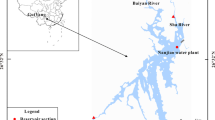Abstract
Dissolved nutrients (NO −3 , PO4 3−, SiO3 2−) and oxygen, chlorophyll- a, pH, and Eh were measured on board during a cruise in August 1988 in the Changjiang Estuary region. Heavy metals, organic matter and carbonate contents were analyzed in laboratory. The results show that geochemical processes in the Changjiang Estuary have dual filtration effect: on the one hand geochemical filtration effect, reflected by ferromanganese oxide flocculation and sedimentation, occurs near the turbidity maximum, and leads to enrichment of heavy metals in suspended matter and sediments; on the other hand biogeochemical filtration, reflected by nutrients consumption, organic matter and carbonate sedimentation and enrichment of trace elements in suspended matter, occurs outside the plume water front. The biogeochemical filtration affects the environmental conditions; the dissolved oxygen and pH increase, in surface water and decrease in bottom water. The biogeochemical filtration effect outside the plume front is more important than the geochemical filtration effect near the turbidity maximum.
Similar content being viewed by others
References
Aminot, A. and M., Chaussepied, 1983. Mannuel des analyses chimiques on milieu marin. CNEXO (ed.), Paris, 393 pp.
Boyle, E. A., S. S. Huested, and B., Grant, 1982. The chemical mass balance of the Amazon, plume: II, copper, nickel and cadmium.Deap-Sea Research,29: 1355–1364.
Chen Banglin and Wu Ling, 1985. Study on interface chemistry of fine sediment particles of the Changjiang Estuary. In: Compilation of Basic Documents for Sewage Drainage of Shanghai City. East China Normal University Press, p. 232–244. (in Chinese)
Chen Banglin, Wu Guoyuan and Pan Dingan, 1988. Investigation of the Changjiang Estuary for sewage drainage of the Shanghai City. East China Normal University Press, 316 pp. (in Chinese)
Chen Jiyu, Shen Huanting and Yun Caixing, 1980. Investigation for Navigation, channel choice in the Changjiang Estuary. In: Changjiang Estuary Research. East China Normal University Press, p. 1148–1212. (in Chinese)
Chen Zexia, 1986. Behaviours of dissolved Cu, Ni and Cd in the Changjiang Estuary. Journal of Oceanography, 8: 48–52. (in Chinese).
Deffino, J.J. and Otto, R. G., 1986. Trace metal transport in two tributaries of the upper Chesapeak Bay: the Susquehanna and Bush Rivers. Marine Chemistry,20: 29–44.
Edmond, J. M., A., Spivack, B. C., Grant, Hu, M. H. and Chen, Z. X., 1983. Chemical dynamics of the estuary of the Changjiang River. In: Sedimentation on the Continental Shelf, with Special Reference to the East China Sea. China Ocean Press, p. 25–264.
Feely, R. A., G. J., Massoth, E. T., Baker, Gendron, J. E., Paulson, A. J. and Grecelius, E. A., 1986. Seasonal and vertical variations in the elemental composition of suspended and settling particulate matter in Puget Sound, Washington. Estuarine,Coastal and Shelf Science,22: 215–239.
Gibbs, R. J., 1983. Coagulation rates of clay minerals and natural sediments.Journal of Sedimentary Petrology 53 (4): 1193–1203.
Hong, H. and D. R., Kester, 1985. Chemical forms of iron in the Connecticut River Estuary.Estuarine, Coastal and Shelf Science,21: 449–459.
Hunter, K. A., and Leodard, M. W., 1988. Colloid stability and aggregation in estuaries: I. Aggregation kinetics of riverine dissolved iron after mixing with seawater.Geochimica et Cosmochimica Acta,52: 1123–1130.
Krangk, K., 1984. The role of flocculation in the filtering of particulate matter in estuaries. In: The Estuary as A Filter (Kennedy, V.S., ed.). Academic Press, p. 169–175.
Matsunage, K., K., Igarashi, S. Fukase, and H., Tsubota, 1984. Behavior of organically bound iron in seawater of estuaries. Estuarine, Coastal and Shelf Science,18: 615–622.
Schubel, J. R. and V.S., Kennedy, 1984. The estuary as a filter: an introduction. In: Estuary as A Filter (Kennedy, V.S., ed.). Academic Press, p. 1–14.
Sharp, J. H., J. R., Pennock, R.M., Church, J.M. Tramontano, and L.A., Cifuentes, 1984. The estuarine interaction of nutrients, organics and metals: a case study in the Delawre Estuary. In: The Estuary as a Filter (Kennedy, V.S., ed.). Academic Press, p. 241–258.
Shi, Z.J., 1986. Inorganic nitrogen in seawater.Bulletin of Shandong College of Oceanography 16 (2): 189–206. (in Chinese)
Xu Zhigang, 1981. Experiment for fine sediment particle aggregation of the Changjiang Estuary.Bulletin of IECR, East China Normal University. (in Chinese)
Author information
Authors and Affiliations
Rights and permissions
About this article
Cite this article
Rucheng, T., Jiyu, C. & Juzhen, Z. Dual filtration effect of geochemical and biogeochemical processes in the Changjiang Estuary. Chin. J. Ocean. Limnol. 9, 33–43 (1991). https://doi.org/10.1007/BF02849787
Received:
Issue Date:
DOI: https://doi.org/10.1007/BF02849787




